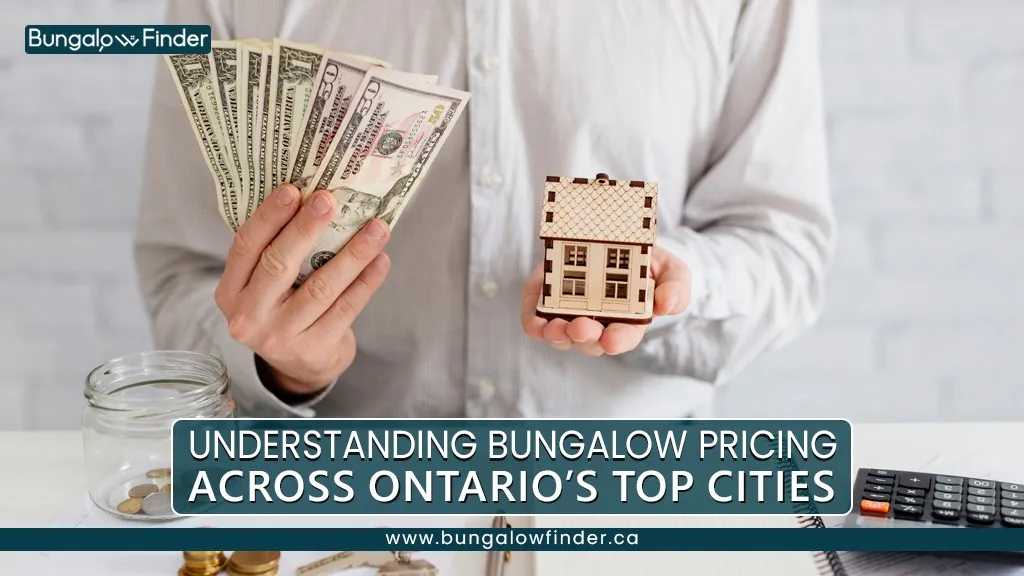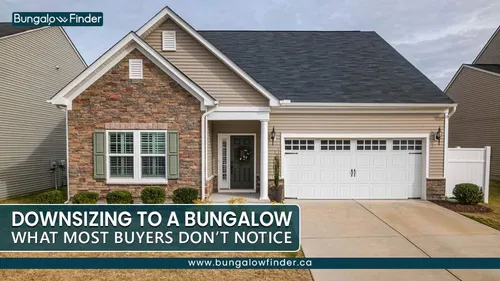Why Bungalows Cost More Per Square Foot in Ontario
Learn why bungalows in Ontario cost more per square foot than two-story homes, and explore pricing trends in Oakville, Mississauga, Milton, and Hamilton.

If you’ve been scrolling through listings lately, you might’ve noticed something strange — bungalows often seem more minor, yet they’re priced higher per square foot than two-story homes. It catches people off guard. Same lot, fewer rooms, but the price looks heavier. Still, there’s logic behind it.
Across Ontario, especially in places like Oakville, Mississauga, Milton, and Hamilton, bungalows sit in their own category. They don’t compete with typical detached homes. They attract a different type of buyer — one who’s not chasing size, but comfort and layout.
Let’s break this down in plain terms.
Why the price per square foot can look higher
A bungalow usually spreads out instead of up. Everything’s on one level — bedrooms, kitchen, living space. That layout means the total square footage is smaller, but it still sits on a lot. The land is where the money goes. So even though you’re getting fewer square feet inside, you’re paying for the same footprint on the ground.
That’s the first reason the number looks high. The second is demand. Not everyone wants stairs, especially older buyers or people planning to age in place. And since most new subdivisions don’t build authentic bungalows anymore, the existing few hold a strong market position.
They’re also easier to live in, easier to renovate, and often easier to rent out. So they check a lot of boxes — that keeps the market value firm, even when everything else fluctuates.
Comparing a few cities
Here’s a rough idea of how bungalow pricing compares right now. These aren’t exact MLS figures; they are just a general snapshot of the trend.
City | Average Bungalow Price | Average Size | Approx. Price per Sq Ft |
Oakville | $1.55M | 1,600 sq ft | $970 |
Mississauga | $1.2M | 1,500 sq ft | $800 |
Milton | $1.05M | 1,450 sq ft | $724 |
Hamilton | $820K | 1,400 sq ft | $586 |
You can spot the pattern right away.
When there aren’t many bungalows left, and the area’s good, the price per square foot shoots up. Oakville tops that list, followed by Mississauga, Milton, and Hamilton at the end.
Oakville
Oakville’s the clearest example of it. Most bungalows here aren’t new. They’re from the 60s or 70s, built on big, quiet lots close to the lake or older tree-lined streets. The kind of neighborhoods that don’t get built anymore. Developers like them because the land is wide and easy to rebuild on. Families want them for the schools and the location. And people downsizing — they love that one-level setup.
You don’t see many of these come up for sale, so when they do, they move fast. Even the smaller ones sell high because the land carries so much value.
Mississauga
Mississauga’s mix is interesting. You’ve got bungalows in Mineola and Lorne Park that look modest outside but sell for over a million easily. Then, newer areas up north have two-story homes that are taking the spotlight. Still, if you find a solid single-level home near transit or schools, it won’t sit long. The cost of a bungalow in Mississauga depends a lot on the pocket you’re in, but the price-per-foot still trends high because of lot size and location.
Milton
Milton doesn’t have many bungalows left either. Most newer homes are two-story. But in the older parts of town — the ones with bigger yards and mature trees — those few single-level homes move quickly. People like the balance here: more space than Mississauga, less chaos than Oakville. Prices are high enough to show demand, but not so high that first-time buyers are shut out completely.
The bungalow price per sq ft in Ontario often looks fairer here because you still get a good lot with it.
Hamilton
Hamilton’s where things still feel accessible. You can find a proper detached bungalow for under $900,000 in decent shape — something unheard of in Oakville or Mississauga. That gap is shrinking, though. Renovated brick bungalows, especially around Westdale, Dundas, and Ancaster, are catching Toronto buyers fast.
The average per-square-foot price might look lower, but percentage-wise, Hamilton’s growth has been faster. The catch? There’s more variation street to street. Some areas jump, others stay level.
Do bungalows always cost more per square foot?
Not always. You’ll see exceptions. A newer two-story home with luxury finishes can easily push past a smaller bungalow in price per square foot. But if you compare similar condition homes, bungalows usually come out higher. It’s partly math, partly psychology.
Also depends on how the listing measures square footage. Some include basement space, some don’t. A finished basement can change that number fast. So never judge two listings strictly by that metric.
What this means if you’re buying or selling
If you’re buying a bungalow, don’t dismiss it because of the price per square foot. They hold value. They’re easier to maintain, easier to rent, and appeal to a wide range of buyers when you sell later.
If you’re selling, show the lifestyle, not the numbers. One-floor living, backyard access, open layouts — those are your selling points. Buyers today care about function more than raw size.
If you’re investing, look at older pockets. Many of these homes sit on expansive lots perfect for duplex conversions or rebuilds. The land itself will likely appreciate faster than the structure.
Market tone right now
Across the Canadian housing market, bungalows are holding steady. They’re not flooding the listings, and that’s precisely why they don’t dip much in value. In Oakville and Mississauga, they’re almost boutique. In Milton, they’re practical. In Hamilton, they’re opportunity-driven.
People are still buying them, even with higher borrowing costs. Why? Because they’re simple, low-maintenance, and adaptable. Not everyone wants an enormous two-story anymore.
Closing thought
So yes, bungalows usually cost more per square foot. But that number doesn’t mean they’re overpriced. It means they’re wanted. They offer something most new homes don’t — space that’s flat, private, and easy to live in.
If you’re comparing bungalows for sale or browsing Canadian homes for sale across these four cities, keep one thing in mind: that extra per-foot cost often buys you long-term comfort and better resale potential.
For anyone serious about finding one, BungalowFinder has updated listings and market updates that make it easier to see what’s really happening in each city before you decide.
FAQs
Is a bungalow more expensive to build?
Most of the time, yes. Since it’s all on one floor, you need more foundation and a bigger roof. That alone adds cost compared to a two-storey home.
Are bungalows more expensive?
They usually are. You’re paying for more land and the comfort of single-level living. Plus, there aren’t many left, which keeps prices strong.
What are the disadvantages of a bungalow?
They take up more land, so you lose yard space. Building costs are higher, too, since everything’s stretched out. And sometimes, privacy’s less because everything’s on one floor.













